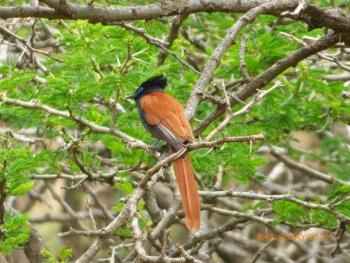- Terpsiphone viridis
Identification
18 cm (7 in) with 10-18 cm (4-7 in) long tail streamers.
Male - black head, neck and underparts, chestnut wings and tail, white wingbar.
Female - browner tint to the underparts, no wingbar and no tail streamers.
Young birds are similar to the female but duller.
The male African Paradise Flycatcher comes in two distinct forms a rufous morph and a white morph. They may even change colour from rufous to white and can sometimes be seen part way through the change with a mixture of white and rufous feathers. The dark head and blue eye are common to both forms. The female always retains the rufous colouring.
African Paradise-Flycatcher (Terpsiphone viridis) is closely related to Black-headed Paradise-Flycatcher (Terpsiphone rufiventer) , and hybrids occur with the underparts a mixture of black and red.
Distribution
Widespread throughout Africa (south of the Sahara Desert) and the Middle East
Western Africa: Mauritania, Senegambia, Senegal, The Gambia, Guinea-Bissau, Guinea, Mali, Sierra Leone, Liberia, Ivory Coast, Burkina Faso, Ghana, Togo, Benin, Nigeria, Niger, Chad, Cameroon, Central African Republic, Equatorial Guinea, Gabon, Congo, Angola
Eastern Africa: South Sudan, Eritrea, Ethiopia, Djibouti, Somalia, Kenya, Uganda, Rwanda, Burundi, Tanzania, Zanzibar, Zambia, Mozambique, Malawi
Southern Africa: Namibia, Botswana, Zimbabwe, South Africa, KwaZulu-Natal, Lesotho, Swaziland
Middle East: Arabian Peninsula, Saudi Arabia, Yemen, Oman
Taxonomy
Subspecies
There are 10 subspecies.[1]
- T. v. viridis:
- Senegal and Gambia to Sierra Leone
- T. v. speciosa:
- Southern Cameroon south to northeastern Angola, east to Democratic Republic of the Congo and southwestern South Sudan
- T. v. ferreti:
- T. v. restricta:
- T. v. kivuensis:
- T. v. suahelica:
- T. v. ungujaensis:
- T. v. plumbeiceps:
- Southern Angola to western Zaire, south-western Tanzania and north-eastern South Africa
- T. v. granti:
- T. v. harterti:
- Southern Arabian peninsula
Habitat
Evergreen, coastal and riverine forests.
Behaviour
Breeding
The clutch consists of 2-3 eggs which are laid in a tiny cup nest in a tree.
Diet
The diet consists of insects, including eggs and larvae, spiders; they also eat some small berries.
References
- Clements, J. F., T. S. Schulenberg, M. J. Iliff, D. Roberson, T. A. Fredericks, B. L. Sullivan, and C. L. Wood. 2017. The eBird/Clements checklist of birds of the world: v2017, with updates to August 2017. Downloaded from http://www.birds.cornell.edu/clementschecklist/download/
- Avibase
- Handbook of the Birds of the World Alive (retrieved October 2016)
- Wikipedia
Recommended Citation
- BirdForum Opus contributors. (2024) African Paradise-Flycatcher. In: BirdForum, the forum for wild birds and birding. Retrieved 31 October 2024 from https://www.birdforum.net/opus/African_Paradise-Flycatcher
External Links








